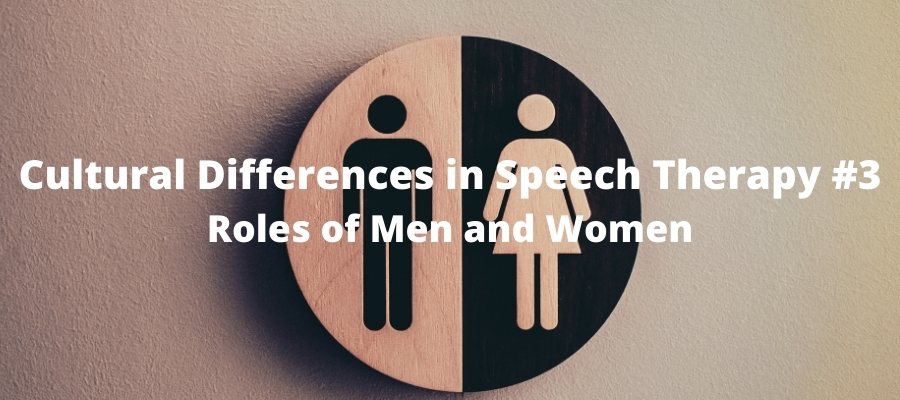Roles of Men and Women is part of a 10-essay series. New? Start here: Cultural Differences in Speech Therapy and Assessment
Gender roles vary across cultures and influence many areas, including education, ownership, choice of profession, and decision-making authority in the family (Tomoeda & Bayles, 2002). Traditionally, some cultures have been described as exhibiting roles of male supremacy (machismo) and maternal submissiveness (marianismo). In these roles, the male is expected to act “macho” and is considered the head of the household and the figure that makes the final family decisions. By comparison, the female is the dutiful family member who will sacrifice her life for her man and children, with child rearing as the exclusive domain of the female family member(s) (Leith, 1986; Lynch & Hanson, 2004; Suárez-Orozco & Páez, 2002).
We see however, that belief in these cultural roles don’t always play out in our therapy and diagnostic settings. Higher education and higher economic independence of women have begun to change traditional female roles and diminished the cultural stereotype of the man as the dominant, authoritative figure (Gutmann, 1996, as cited in Iglesias, 2002; Powell, Zambrana, and Silva-Palacios, 1995).
What’s dangerous about this cultural parameter is that it can lead to a misinterpretation of how much someone is invested in the their child.
The Roles of Men and Women and Assessment
Our goal with assessment, aside from our own cultural beliefs, is to gather accurate information from the family that informs our clinical decision. Here are a few ways that misunderstanding this cultural parameter can play out poorly for all involved.
- In cultures where one member (typically the male) is considered to be the head of the family, clinicians should be aware that it may be considered inappropriate for the clinician to speak to the mother before addressing the father if both parents are present.
- If one member is not present for meetings or interactions, it should not be interpreted as a lack of involvement (Lynch & Hanson, 2004). We typically work with large families where the mother manages the household and the father manages 1-3 jobs. Each sees their role as important to the family .
- If a parent wants to take paperwork home to discuss it before signing consent, it should not be seen as distrust or disagreement with your findings. Quite the contrary. Some cultures see a strong marriage as dependent on mutual agreement or one’s role as the decision maker.
It is important that the clinician respects these roles and adheres to the cultural norms in order to form a trusting and stable relationship with the family. However, the clinician should also recognize the increasing independence of Latino women and the subsequent changing dynamics of the Latino family (Vega, 1995). Therefore, it is important to investigate the roles of each family and address them accordingly while respecting traditional roles and responsibilities.
Spectrum of Gender Roles
As we discuss gender roles, it is important to talk about the value of all partnerships within a family. The American Speech-Language-Hearing Associations states that cultural diversity and competence includes gender identity (encompasses gender expression), sex and sexual orientation (ASHA, 2017). The definition of a family has changed for the better, and we acknowledge that the aforementioned research does not adhere to same-sex partnerships. Additionally, this brings up the spectrum of humans who do not adhere to binary gender roles. We whole-heartedly acknowledge that more research needs to be done in this arena. As we work with students, clients and their families, understanding the continuum of gender (how one identifies), sex (biological differences between males and females) and sexual orientation is valuable.
Let’s be frank, it bothers us to see behaviors that relate to gender and roles of men and women that do not comply with how we were raised and our belief system. We do not need to change nor accept behavior that is outright demeaning. But taking all of this into consideration, can we:
- Collect accurate information to make an informed clinical decision?
- Create a plan that the parents, clinician, and school agree with?
If we focus on the task at hand, we can more effectively produce an outcome that is suitable for everyone.
Questions for Big Thinking
How did your grandmother’s view of gender differ from your mother’s, and differ from yours? How did your grandfather’s view of gender differ from your father’s and differ from yours? What message are you sharing with your children? Do you think your country is more progressive than others? Do you think that globally things are changing or remaining the same? Just think about it or share your comments below.
In our next essay we will talk about Concepts of Class and Status.
Want to read about all the cultural parameters in one place, get CEUs and a helpful chart?



